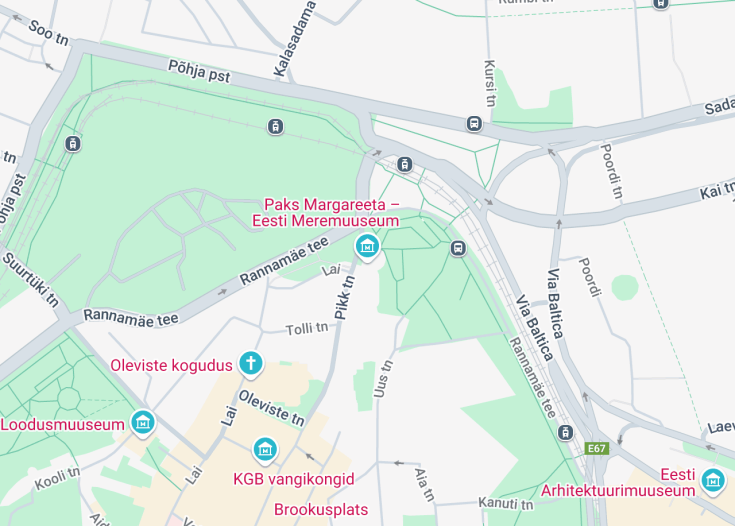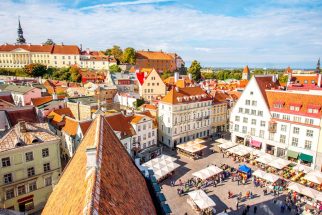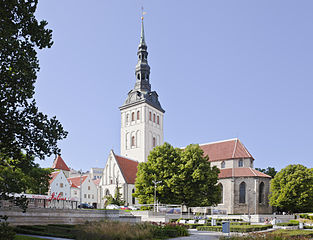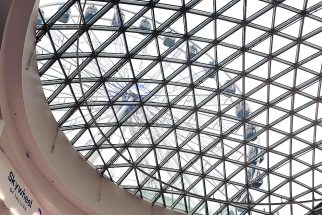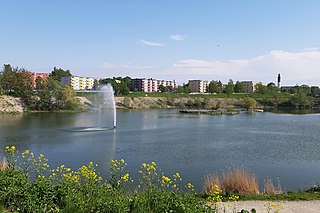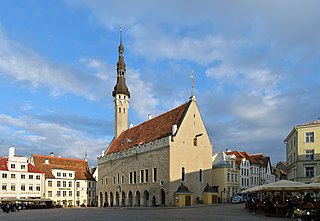Estonian Maritime Museum: Dive into Estonia’s Nautical Heritage
Located in the heart of Tallinn, the Estonian Maritime Museum stands as a testament to Estonia’s rich and enduring relationship with the sea. Housed in a historic seafaring building in the Old Town, this museum offers visitors a captivating journey through maritime history, showcasing everything from ancient ships to modern vessels. The museum is particularly renowned for its impressive collection of maritime artifacts, including ship models, navigation instruments, and maritime artwork. For tourists, it provides an engaging and educational experience, highlighting Estonia’s pivotal role in Baltic maritime trade and naval defense. Interactive exhibits and multimedia presentations make the museum a family-friendly destination, while its picturesque location by the harbor offers stunning views of the Baltic Sea. Whether you’re a history enthusiast, a maritime aficionado, or simply seeking an insightful cultural experience, the Estonian Maritime Museum in Tallinn is a must-visit attraction that beautifully encapsulates the spirit and significance of Estonia’s seafaring past and present.
Explore Engaging Exhibits and Interactive Displays
At the Estonian Maritime Museum, visitors can immerse themselves in a variety of interactive exhibits that bring maritime history to life. One of the highlights is the impressive collection of ship models, meticulously crafted to represent vessels from different eras and regions. Additionally, the museum features navigation simulators that allow guests to experience the challenges of steering a ship through turbulent waters. For those interested in naval warfare, there are detailed exhibits on Estonia’s naval history, including relics from significant maritime battles. The museum also hosts temporary exhibitions that focus on specific themes, such as maritime art or the technological advancements in shipbuilding. Educational workshops and guided tours are available, making it an ideal destination for both casual visitors and school groups. With its blend of historical artifacts and modern technology, the museum offers a dynamic and engaging experience for all ages.
Discover the Storied Lighthouse Collection
One of the most fascinating aspects of the Estonian Maritime Museum is its extensive collection of historic lighthouses and related maritime navigation tools. These exhibits provide a unique glimpse into the vital role lighthouses have played in ensuring the safety of sea travel along Estonia’s rugged coastline. Visitors can explore detailed models of iconic lighthouses, learn about the lives of lighthouse keepers, and understand the technological advancements that have shaped maritime navigation. An interesting fact about the museum is that it houses the original lens from the renowned Suur-Pääsky Lighthouse, which has been operational since the 19th century. This artifact not only illustrates the engineering prowess of the time but also serves as a symbol of Estonia’s maritime resilience. The lighthouse exhibits are complemented by stunning panoramic views from the museum’s vantage point, allowing guests to appreciate the scenic beauty that has inspired sailors for generations.
Discover the Wonders of the Estonian Maritime Museum
The Estonian Maritime Museum offers an immersive journey into Estonia’s rich maritime heritage, making it an ideal destination for history enthusiasts, families, and curious travelers alike. Visitors can explore a vast collection of maritime artifacts, including historic ship models, navigational instruments, and interactive exhibits that bring Estonia’s seafaring past to life.
Perfectly suited for those interested in naval history, marine biology, and maritime technology, the museum provides insightful narratives that cater to all ages. The engaging displays and knowledgeable staff ensure that every visitor gains a comprehensive understanding of Estonia’s relationship with the sea.
Strategically integrated into Tallinn’s broader cultural itinerary, the Estonian Maritime Museum complements nearby attractions such as the Seaplane Harbour and Telliskivi Creative City. This makes it a seamless addition to a day of exploring the city’s vibrant waterfront and historical landmarks.
For a unique experience, consider joining one of the museum’s guided tours, where expert guides share lesser-known stories and anecdotes about Estonia’s maritime adventures. Additionally, the museum’s waterfront location offers picturesque views, perfect for photography enthusiasts looking to capture the essence of Tallinn’s maritime charm.
The museum also hosts special exhibitions and events throughout the year, providing fresh perspectives and deeper insights into specific aspects of maritime history. Whether you’re a seasoned traveler or a first-time visitor, the Estonian Maritime Museum promises a memorable and educational experience.
When to Visit the Estonian Maritime Museum for the Best Experience
The optimal time to explore the Estonian Maritime Museum is during the spring and summer months when the weather is pleasant, and the waterfront setting is in full bloom. These seasons offer longer daylight hours, allowing visitors to fully enjoy both the indoor exhibits and the scenic outdoor areas.
Special Maritime Festival
Visiting during the annual Maritime Festival provides a unique opportunity to experience live demonstrations, ship parades, and interactive workshops. This event showcases Estonia’s vibrant maritime culture and offers an engaging way to immerse yourself in the local traditions.
Accessibility and Limitations
While the Estonian Maritime Museum strives to accommodate all visitors, there are certain limitations to be aware of.
Accessibility
The museum is fully accessible to visitors with disabilities, featuring wheelchair ramps, elevators, and accessible restrooms. Additionally, there are tactile exhibits for visually impaired guests and sign language services available upon request.
Limitations
- Photography is restricted in certain exhibit areas to preserve artifacts.
- Large bags and backpacks are not permitted inside the main exhibition halls.
- Children under 3 years old must be accompanied by an adult at all times.
Notes to visitors
- Audio guides are available in multiple languages for a more in-depth experience.
- Refreshments can be purchased at the museum café, but outside food is not allowed.
- Guided tours are available but must be booked in advance.
General informations
Details for your visit to Estonian Maritime Museum
Location
The Estonian Maritime Museum is conveniently situated near Tallinn’s bustling port area, making it easily accessible from major transport hubs.
Address:
Meremuuseumi 8, 10415 Tallinn, Estonia
Opening Hours
The museum is open to the public daily from 10:00 AM to 6:00 PM, allowing ample time for visitors to explore the exhibits at their own pace. For the best experience, plan your visit during weekday mornings when the museum is less crowded.
How to Reach the Estonian Maritime Museum
Getting to the Estonian Maritime Museum from Tallinn’s city center is straightforward with several transportation options available.
By Tram
The museum is easily accessible by tram. Board tram number 1 or 4 from the city center and alight at the Sadama station. The journey takes approximately 15 minutes, and the museum is a short walk from the stop.
| Route |
Distance |
Travel time |
| From City Center |
3 miles (4.8 km) |
15 minutes |
| From Airport |
10 miles (16 km) |
30 minutes |
| From Tallinn Bus Station |
2 miles (3.2 km) |
10 minutes |
By Bus
Alternatively, several bus lines connect the city center to the museum. Bus number 2 and 7 run frequently and take approximately 20 minutes to reach the vicinity of the Estonian Maritime Museum.
| Route |
Distance |
Travel time |
| From Rotermanni Quarter |
2 miles (3.2 km) |
10 minutes |
| From Freedom Square |
4 miles (6.4 km) |
20 minutes |
| From Kalamaja District |
3 miles (4.8 km) |
15 minutes |
Nearby Attractions
- Seaplane Harbour – 0.5 miles (0.8 km)
- Freedom Square – 2 miles (3.2 km)
- Kalamaja District – 3 miles (4.8 km)
- Tallinn Old Town – 3.5 miles (5.6 km)
- Telliskivi Creative City – 2.5 miles (4 km)
- Alexander Nevsky Cathedral – 3.2 miles (5.2 km)
- Toompea Castle – 3.8 miles (6.1 km)
- Rotermann Quarter – 2.1 miles (3.4 km)
- Kumu Art Museum – 4 miles (6.4 km)
- Lotus Centenar – 1.8 miles (2.9 km)
- Narva Gate – 3.3 miles (5.3 km)
- St. Olaf’s Church – 3.4 miles (5.5 km)
- Estonian Open Air Museum – 5 miles (8 km)
- Viru Bog Nature Reserve – 6 miles (9.7 km)
- Tallinn TV Tower – 6.2 miles (10 km)
Common questions
What Are the Main Exhibits at the Estonian Maritime Museum?
The Estonian Maritime Museum boasts a diverse array of exhibits that showcase Estonia’s rich maritime heritage. Key highlights include: – Ship Models and Blueprints: Detailed replicas and original designs of historical Estonian vessels. – Maritime Technology: Displays featuring navigation instruments, engines, and other technological advancements used in shipping. – Exhibition Ships: The museum houses actual ships, such as the *Vana Piraat* and the *Loodus*, allowing visitors to explore maritime vessels firsthand. – Historical Documents and Photographs: Archival materials that provide insights into Estonia’s naval history and maritime activities. – Interactive Displays: Engaging exhibits that utilize multimedia to educate visitors about maritime trade, fishing, and sea exploration. These exhibits collectively offer a comprehensive overview of Estonia’s relationship with the sea, from ancient seafaring practices to modern maritime industries.
What Is the History of the Estonian Maritime Museum?
Established in 1945, the Estonian Maritime Museum has played a pivotal role in preserving and presenting Estonia’s maritime history. Initially located in Tallinn’s Old Town, the museum focused on documenting the nation’s seafaring traditions and naval architecture. Over the decades, it expanded its collections to include a wide range of maritime artifacts, from ship models and nautical instruments to historical photographs and documents. In 1996, the museum moved to its current location in the former Estonian Ministry of Foreign Affairs building, a structure with its own historical significance. This relocation allowed for larger exhibition spaces and the inclusion of actual ships, enhancing the visitor experience. Today, the museum serves as both an educational institution and a cultural landmark, offering insights into Estonia’s maritime past and its ongoing relationship with the sea.
What Kind of Maritime Artifacts Are Displayed in the Museum?
The Estonian Maritime Museum features an extensive collection of maritime artifacts that reflect the nation’s seafaring legacy. Notable items include: – Ship Models: Intricately crafted replicas of traditional Estonian boats and ships, illustrating various designs and construction techniques. – Nautical Instruments: Historical navigation tools such as compasses, sextants, and astrolabes used by sailors for charting courses. – Marine Equipment: Components like sails, ropes, anchors, and engines that highlight the technological evolution of maritime vessels. – Personal Items: Artifacts belonging to sailors and maritime workers, offering a personal glimpse into the lives of those who navigated the seas. – Photographs and Maps: Visual documentation of maritime activities, ship routes, and significant naval events in Estonian history. – Submarine Artifacts: Items recovered from Estonia’s submarine history, including parts of vessels and related paraphernalia. These artifacts not only preserve Estonia’s maritime traditions but also provide educational opportunities for visitors to understand the complexities of seafaring life.
Are There Interactive Displays or Activities for Children at the Estonian Maritime Museum?
Yes, the Estonian Maritime Museum offers a variety of interactive displays and activities designed to engage younger visitors. These include: – Hands-On Exhibits: Interactive panels where children can learn about shipbuilding, navigation, and marine biology through tactile experiences. – Educational Workshops: Programs that teach kids about maritime history, marine engineering, and environmental conservation through practical activities. – Multimedia Presentations: Engaging videos and simulations that illustrate maritime concepts and historical events in an accessible manner. – Treasure Hunts and Quizzes: Fun, themed activities that encourage exploration of the museum’s exhibits while testing knowledge of maritime topics. – Storytelling Sessions: Interactive storytelling that brings maritime tales and legends to life, fostering a deeper connection with the sea. These child-friendly features ensure that young visitors have an enjoyable and informative experience, sparking interest in Estonia’s maritime heritage.
Does the Museum Offer Guided Tours or Educational Programs?
Absolutely, the Estonian Maritime Museum provides a range of guided tours and educational programs tailored to different audiences: – Guided Tours: Led by knowledgeable staff, these tours offer in-depth insights into the exhibits, highlighting significant artifacts and historical narratives. – School Programs: Customized educational sessions aligned with school curricula, focusing on maritime history, technology, and environmental studies. – Workshops and Seminars: Interactive workshops for various age groups that delve into topics like shipbuilding, navigation, and marine conservation. – Special Events: Lectures, demonstrations, and interactive sessions featuring experts in maritime fields, providing opportunities for learning and engagement. – Private Tours: Customized tours for groups, offering personalized exploration of the museum’s collections and exhibits. These programs are designed to enhance the visitor experience, providing educational value and fostering a deeper understanding of Estonia’s maritime culture.
What Is the Architecture or Design Style of the Estonian Maritime Museum Building?
The Estonian Maritime Museum is housed in the historic Estonian Ministry of Foreign Affairs building, a fine example of Neoclassical architecture. Constructed in the early 20th century, the building features: – Symmetrical Facade: Balanced proportions and ornate detailing typical of Neoclassical design. – Tall Columns and Pediments: Grand entrances adorned with columns and triangular pediments, emphasizing grandeur and formality. – Large Windows: Expansive windows that allow natural light to illuminate the interior spaces, enhancing the museum’s exhibits. – Decorative Elements: Intricate moldings, friezes, and sculptures that add artistic value and historical context to the structure. The building’s architectural elegance complements the museum’s maritime exhibits, providing a stately and dignified environment that honors Estonia’s naval heritage.
How Does the Estonian Maritime Museum Contribute to Maritime Conservation?
The Estonian Maritime Museum plays a significant role in maritime conservation through various initiatives and activities: – Artifact Preservation: Employing advanced conservation techniques to maintain and protect maritime artifacts, ensuring their longevity for future generations. – Research and Documentation: Conducting studies on marine ecosystems, shipbuilding practices, and historical maritime activities to inform conservation efforts. – Public Awareness: Hosting exhibitions and educational programs that highlight the importance of preserving marine environments and maritime heritage. – Collaborations: Partnering with environmental organizations, academic institutions, and government agencies to promote sustainable maritime practices. – Restoration Projects: Undertaking restoration of historical ships and maritime structures, preserving physical examples of Estonia’s seafaring legacy. Through these efforts, the museum not only safeguards Estonia’s maritime history but also advocates for the sustainable management of marine resources.
What Educational Resources Are Available at the Museum?
The Estonian Maritime Museum offers a variety of educational resources designed to cater to diverse learning needs: – Exhibit Labels and Guides: Comprehensive descriptions and informational panels accompanying each exhibit, providing detailed insights into maritime history and technology. – Educational Publications: Brochures, catalogs, and research papers available for visitors interested in deeper exploration of specific topics. – Digital Resources: Interactive maps, virtual tours, and online databases accessible through the museum’s website, facilitating remote learning. – Learning Centers: Dedicated spaces within the museum where visitors can engage with hands-on activities, multimedia presentations, and educational games. – Library and Archives: A collection of books, journals, and archival materials available for research and study, supporting academic pursuits in maritime studies. These resources enhance the educational experience, making the museum a valuable tool for both formal education and personal enrichment.
Are There Special Exhibits or Permanent Collections at the Estonian Maritime Museum?
Yes, the Estonian Maritime Museum features both permanent collections and special exhibits that rotate periodically: – Permanent Collections: These include core exhibits that cover various aspects of Estonia’s maritime history, such as shipbuilding, navigation, trade, and naval warfare. Notable items include historical ship models, nautical instruments, and maritime art. – Special Exhibits: The museum regularly hosts temporary exhibitions that focus on specific themes, events, or innovations related to maritime activities. These may feature guest curators, contemporary maritime issues, or collaborative displays with other institutions. – Rotating Displays: Certain sections of the museum are dedicated to rotating exhibits, allowing for a fresh and dynamic visitor experience each time. These may highlight new acquisitions, restoration projects, or unique artifacts. – Interactive Installations: Temporary installations that engage visitors through technology, such as virtual reality simulations of maritime environments or interactive storytelling modules. This blend of permanent and special exhibits ensures that the museum remains both a repository of longstanding maritime heritage and a platform for contemporary exploration and education.
What Facilities Are Available at the Museum, Such as Restrooms and Cafeteria?
The Estonian Maritime Museum is equipped with a range of facilities to ensure visitor comfort and convenience: – Restrooms: Clean and accessible restrooms are strategically located throughout the museum, accommodating visitors with varying needs. – Cafeteria and Café: On-site dining options offer a selection of beverages, snacks, and light meals, allowing visitors to relax and refresh during their visit. – Gift Shop: A retail area featuring maritime-themed souvenirs, books, and memorabilia, providing visitors with the opportunity to take home a piece of the museum experience. – Seating Areas: Comfortable seating spaces are available in exhibition halls and common areas, offering places to rest and reflect on the exhibits. – Accessibility Features: Elevators, ramps, and designated parking spaces ensure that the museum is accessible to all visitors, including those with mobility challenges. – Wi-Fi Access: Complimentary wireless internet is available, enabling guests to access digital resources and share their experiences online. These facilities contribute to a welcoming and user-friendly environment, enhancing the overall visitor experience at the Estonian Maritime Museum.
Is the Estonian Maritime Museum Accessible for Visitors with Disabilities?
Yes, the Estonian Maritime Museum is committed to providing an inclusive and accessible environment for all visitors, including those with disabilities. Accessibility features include: – Physical Access: The museum is equipped with ramps, elevators, and wide doorways to accommodate wheelchairs and other mobility devices, ensuring easy navigation throughout the premises. – Accessible Restrooms: Designated restrooms are available, featuring amenities such as grab bars and spacious interiors to support the needs of visitors with disabilities. – Assistive Listening Devices: For visitors with hearing impairments, assistive listening devices are available during guided tours and presentations. – Braille and Tactile Materials: Informational materials, including exhibit descriptions and maps, are provided in Braille and tactile formats to assist visually impaired guests. – Sign Language Interpretation: Sign language interpreters can be requested for group tours or special events, facilitating effective communication and engagement. – Service Animal Policies: The museum welcomes service animals, adhering to international guidelines to ensure a comfortable visit for guests relying on these companions. These comprehensive accessibility measures demonstrate the museum’s dedication to ensuring that all individuals can enjoy and benefit from its maritime heritage offerings.
What Is the Significance of the Notable Artifacts Housed in the Estonian Maritime Museum?
The Estonian Maritime Museum houses numerous notable artifacts that hold significant historical, cultural, and technological importance: – Historical Ship Models: Detailed representations of Estonia’s maritime vessels provide insights into shipbuilding techniques and naval architecture spanning centuries. – Nautical Instruments: Instruments like sextants and compasses illustrate the evolution of navigation technology and its impact on maritime exploration and trade. – Submarine Artifacts: Items recovered from Estonia’s submarine history shed light on naval warfare, underwater engineering, and maritime security during different eras. – Maritime Art and Decor: Paintings, sculptures, and decorative pieces associated with the sea reflect the artistic interpretation of maritime themes and the region’s connection to the ocean. – Personal Belongings of Sailors: Artifacts such as clothing, tools, and personal items offer a personal perspective on the lives of those who worked and traveled by sea. – Shipwreck Salvage Items: Recovered treasures from shipwrecks provide tangible evidence of historical maritime routes, trade goods, and naval conflicts. Each artifact not only preserves a piece of Estonia’s maritime past but also serves as a tangible link to the broader narrative of human interaction with the sea. These items enhance the museum’s role as a guardian of maritime history and a facilitator of cultural heritage.
HelloMondo review

"A fascinating dive into Estonia's maritime history. Engaging exhibits and knowledgeable staff make it a must-visit for enthusiasts."
Is the Estonian Maritime Museum in Tallinn Worth Visiting?
The Estonian Maritime Museum in Tallinn offers an insightful journey into the nation’s rich naval heritage. Visitors can explore a diverse range of exhibits, from historic ships to interactive displays that cater to all ages. The museum’s location by the waterfront provides a picturesque backdrop, enhancing the overall experience. Additionally, the friendly and knowledgeable staff ensure that guests receive comprehensive information, making the visit both educational and enjoyable. Whether you’re a history buff or simply looking for an engaging activity, the Maritime Museum stands out as a top attraction in Estonia’s capital.










